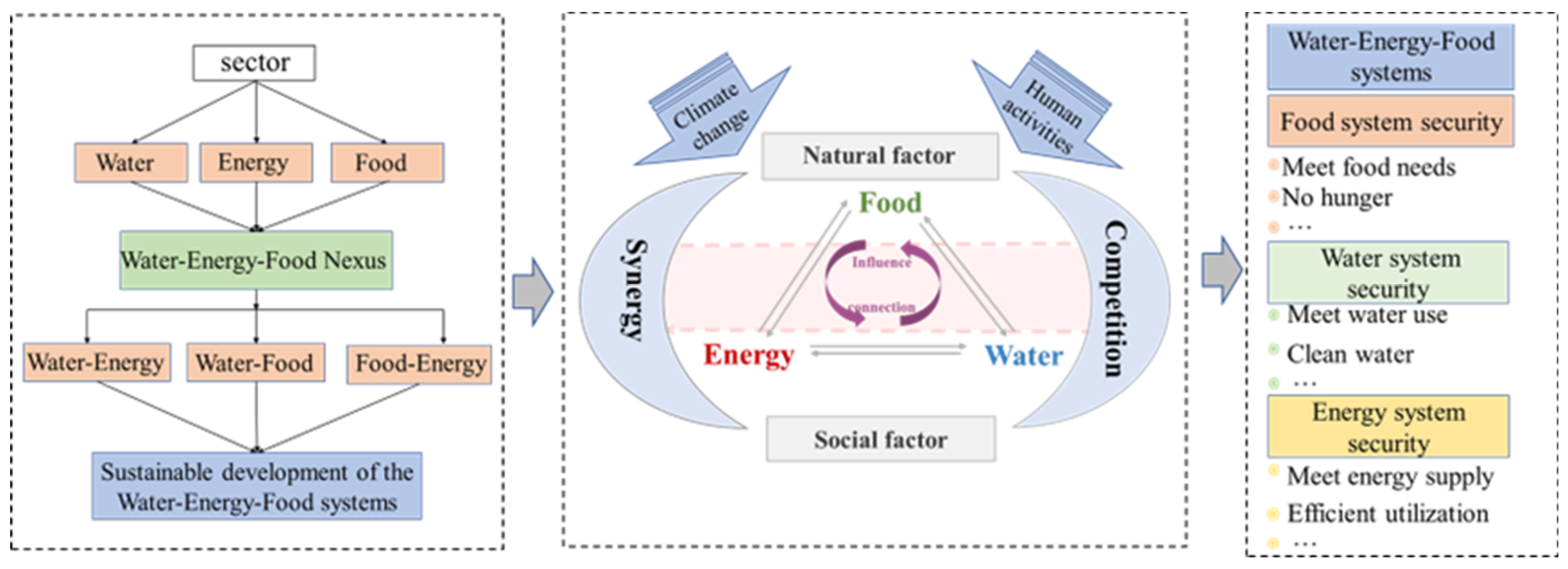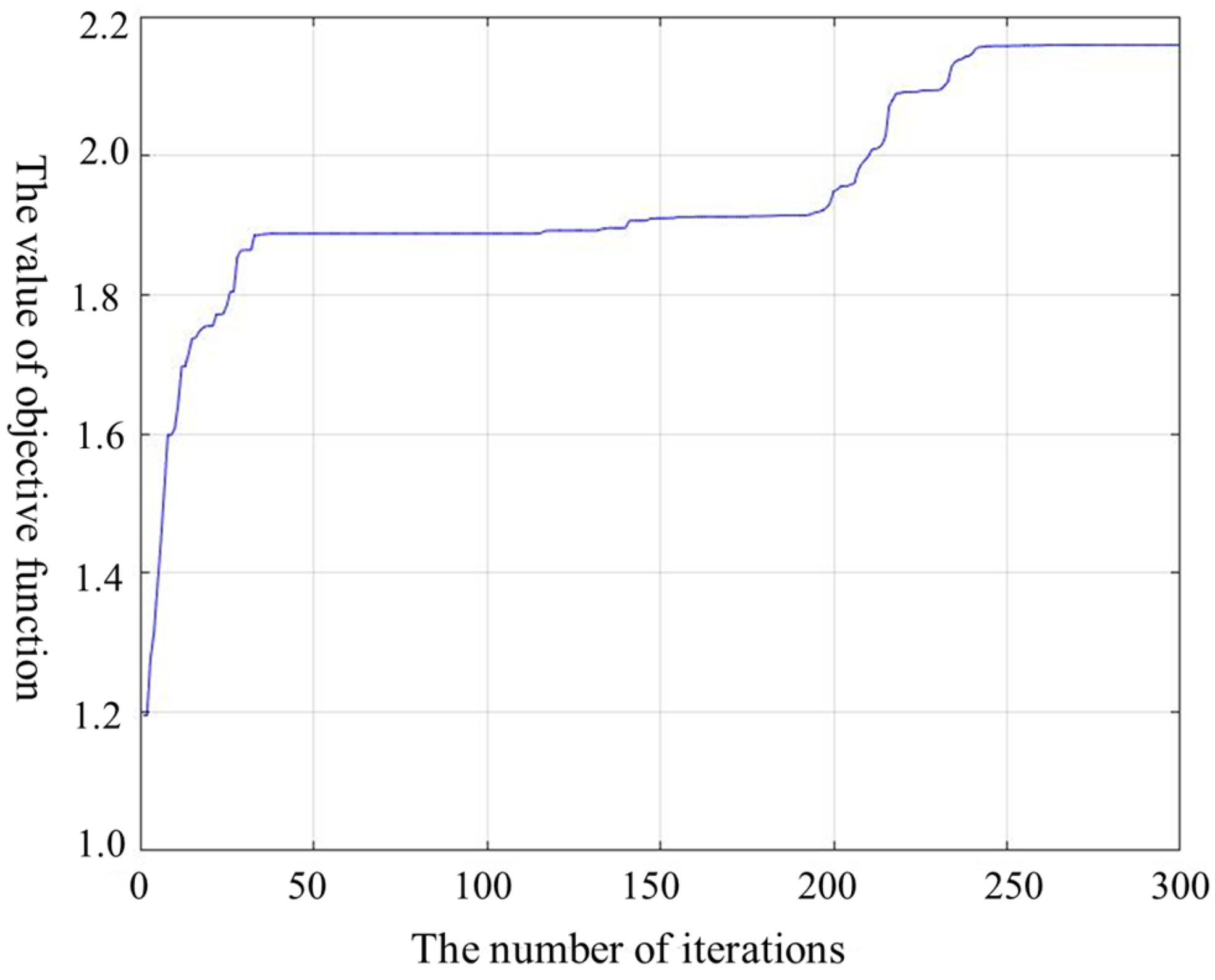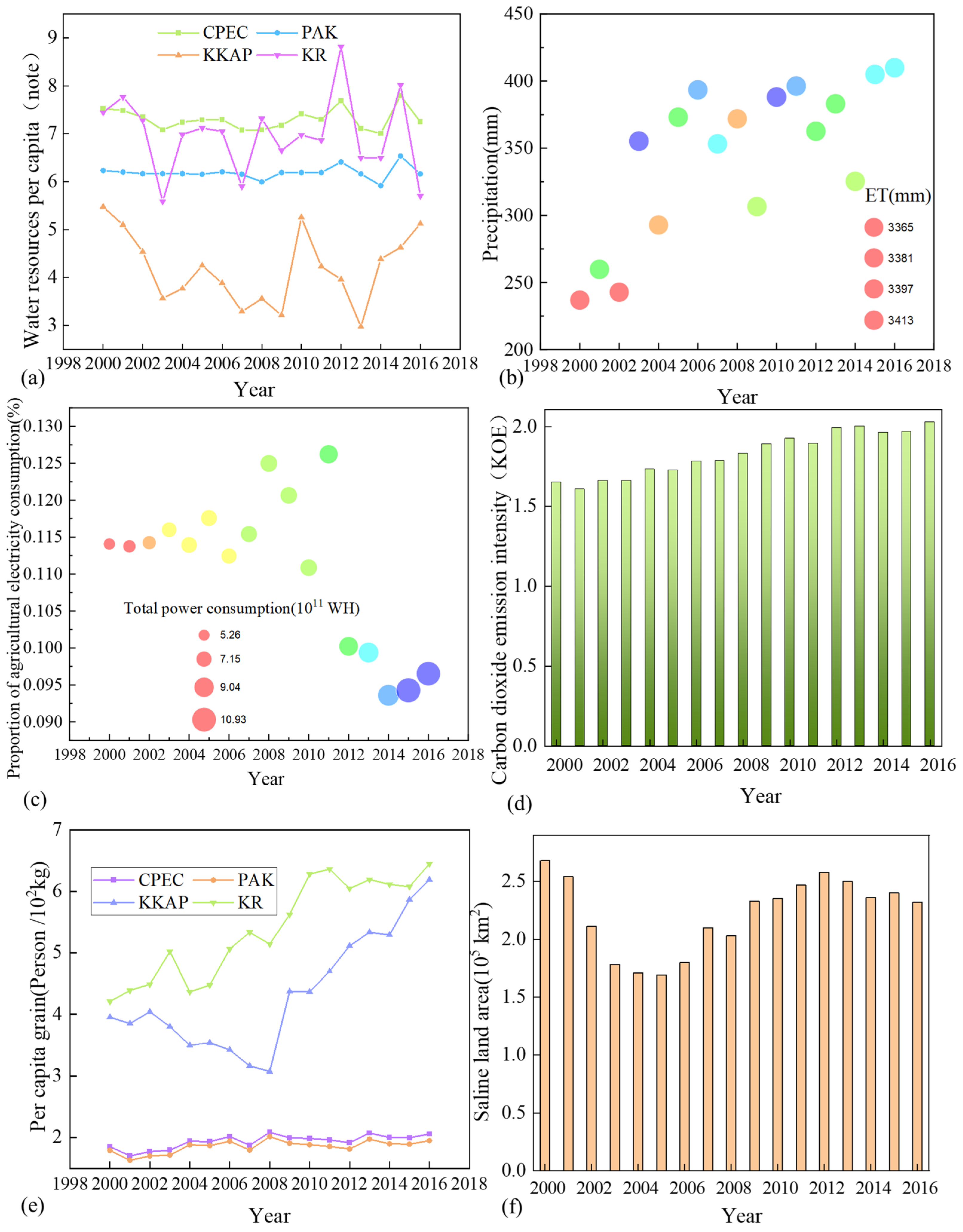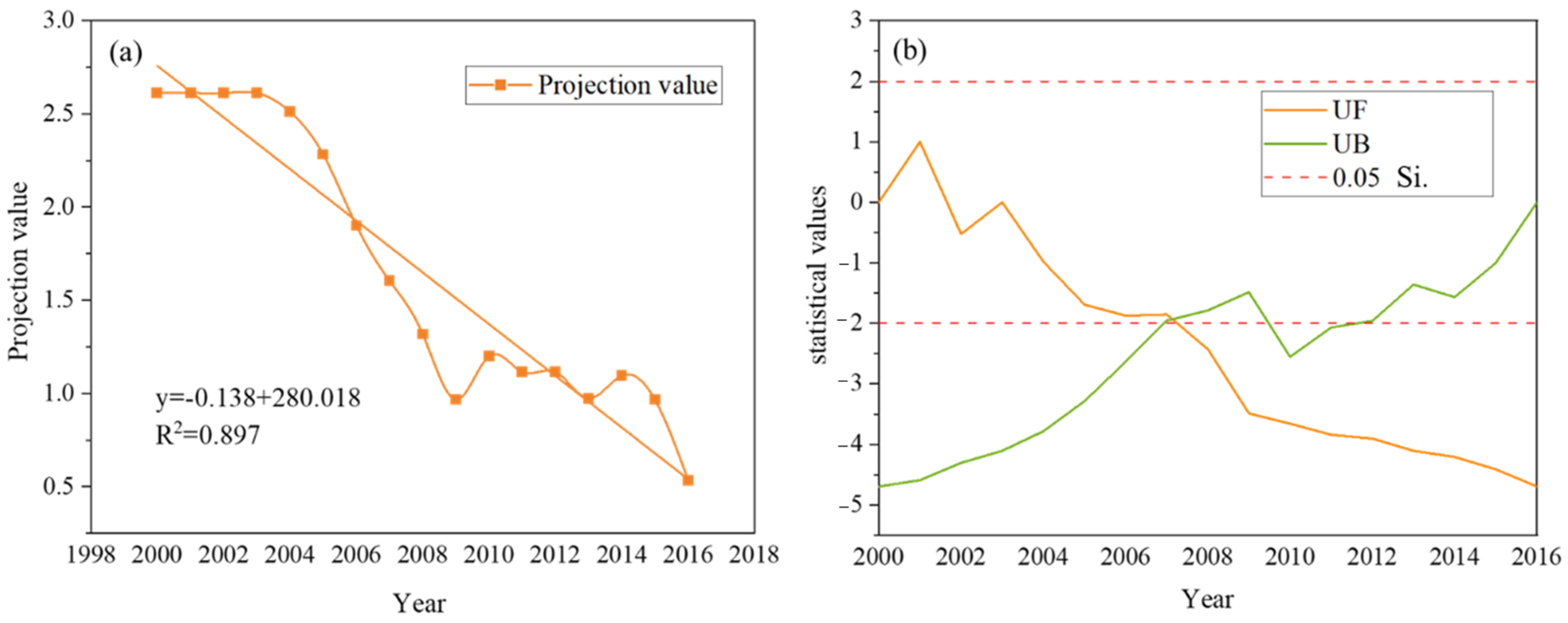Comprehensive Evaluation of Water–Energy–Food System Security in the China–Pakistan Economic Corridor
Abstract
:1. Introduction
2. Methodology and Data
2.1. Study Area
2.2. Data Sources
2.3. Methods
2.3.1. Synergy Competition Mechanism of the Regional WEF System
2.3.2. Establishment of the Security Assessment Indicators System
Principles for the Establishment of the Indicators System
Indicator Selection
2.3.3. Projection Pursuit Model Based on a Real-Code Accelerated Genetic Algorithm
Model Implementation Process
- (1)
- Normalization of the assessment indicators system
- (2)
- Construction of the projection index function
- (3)
- Optimization of the projection indicator function based on the real-code accelerated genetic algorithm
Classification of Evaluation Results
2.3.4. Mann–Kendall (MK) Test
3. Results
3.1. Single Subsystem Analysis
3.2. Two–Two Cooperative Subsystem Analysis
3.3. Security Analysis of the WEF System
3.3.1. MK Mutation Trend Analysis
3.3.2. WEF System Security Level in Each Year
4. Discussion
4.1. WEF System Optimization Suggestions
4.2. WEF System Management Policy Recommendations
4.3. Deficiencies and Future Work
5. Conclusions
- (1)
- In the single subsystem, due to the increase in population and economic development, the security of the water resources and energy subsystem of the CPEC shows a declining trend, while the increase in food output shows a rising trend in food subsystem security.
- (2)
- In the two–two cooperative subsystem, the security of the WE and EF subsystems of the CPEC has been declining due to poor resource coordination and management. In recent years, the security of the WF subsystem has been slowly increasing as the proportion of agricultural water consumption in the CPEC has declined.
- (3)
- From 2000 to 2016, the overall security of the CPEC WEF system showed a downward trend. From 2000 to 2005, the system was relatively safe (level IV); in 2006–2007, it was basically safe (level III); in 2008–2015, it was unsafe (level II); in 2016, it was very unsafe (level I).
- (4)
- The management of water, energy, food, and other resources in the CPEC is chaotic. However, strengthening comprehensive management will greatly improve the utilization efficiency of these resources and, at the same time, make the safety of the WEF system more stable. Therefore, strengthening the utilization and allocation of water resources, adopting reasonable water management policies, adjusting energy and industrial structures, and optimizing agricultural planting patterns are all vital to the sustainable development of water, energy, and food in the CPEC.
Supplementary Materials
Author Contributions
Funding
Conflicts of Interest
References
- El-Gafy, I. Water–food–energy nexus index: Analysis of water–energy–food nexus of crop’s production system applying the indicators approach. Appl. Water Sci. 2017, 7, 2857–2868. [Google Scholar] [CrossRef] [Green Version]
- Liu, J.; Mao, G.; Hoekstra, A.Y.; Wang, H.; Wang, J.; Zheng, C.; Yan, J. Managing the energy-water-food nexus for sustainable development. Appl. Energy 2018, 210, 377–381. [Google Scholar] [CrossRef]
- Zhang, T.; Tan, Q.; Yu, X.; Zhang, S. Synergy assessment and optimization for water-energy-food nexus: Modeling and application. Renew. Sustain. Energ. Rev. 2020, 134, 110059. [Google Scholar] [CrossRef]
- Chai, J.; Shi, H.; Lu, Q.; Hu, Y. Quantifying and predicting the Water-Energy-Food-Economy-Society-Environment Nexus based on Bayesian networks-a case study of China. J. Clean. Prod. 2020, 256, 120266. [Google Scholar] [CrossRef]
- Duan, W.; Chen, Y.; Zou, S.; Nover, D. Managing the water-climate-food nexus for sustainable development in Turkmenistan. J. Clean. Prod. 2019, 220, 212–224. [Google Scholar] [CrossRef]
- Hu, Y.; Duan, W.; Chen, Y.; Zou, S.; Kayumba, P.M.; Sahu, N. An integrated assessment of runoff dynamics in the Amu Darya River Basin: Confronting climate change and multiple human activities, 1960–2017. J. Hydrol. 2021, 603, 126905. [Google Scholar] [CrossRef]
- World Health Organization. Trends in Maternal Mortality 2000 to 2017: Estimates by WHO, UNICEF, UNFPA, World Bank Group and the United Nations Population Division; World Health Organization: Geneva, Switzerland, 2019. [Google Scholar]
- D’Odorico, P.; Davis, K.F.; Rosa, L.; Carr, J.A.; Chiarelli, D.; Dell’Angelo, J.; Rulli, M.C. The global Water-Energy-Food nexus. Rev. Geophys. 2018, 56, 456–531. [Google Scholar] [CrossRef]
- Hoff, H. Understanding the Nexus. Background paper for the Bonn 2011 Nexus conference: The Water, Energy and Food Security Nexus; Stockholm Environment Institute: Stockholm, Sweden, 2011. [Google Scholar]
- Adnan, H. Water-Food-Energy Nexus in Asia and the Pacific; United Nations ESCAP: Bangkok, Thailand, 2013; p. 72. [Google Scholar]
- FAO. The Water-Energy-Food Nexus: A New Approach in Support of Food Security and Sustainable Agriculture; Food and Agriculture Organization (FAO) of the United Nation: Rome, Italy, 2014. [Google Scholar]
- Lin, Z.; Liu, X.; Chen, Y.; Fu, B. Research progress and prospect of the relationship between water, food and energy. J. Geogr. 2021, 76, 1591–1604. (In Chinese) [Google Scholar]
- Zhao, A.; Zhu, X.; Liu, X.; Pan, Y.; Zuo, D. Impacts of land use change and climate variability on green and blue water resources in the Weihe River Basin of northwest China. Catena 2016, 137, 318–327. [Google Scholar] [CrossRef]
- Ge, J.; Lei, Y. Policy options for non-grain bioethanol in China: Insights from an economy-energy-environment CGE model. Energy Policy 2017, 105, 502–511. [Google Scholar] [CrossRef]
- Zhang, P.; Zhou, X. The latest development of food security research abroad and its enlightenment to China. Teach. Res. 2014, 7, 93–101. (In Chinese) [Google Scholar]
- Wang, C.; Tian, L.; Yu, M.; Liu, Y. Summary of research on water-energy coupling in electric power industry. Chin. Environ. Sci. 2018, 38, 4742–4748. [Google Scholar]
- Ghani, H.U.; Silalertruksa, T.; Gheewala, S.H. Water-energy-food nexus of bioethanol in Pakistan: A life cycle approach evaluating footprint indicators and energy performance. Sci. Total Environ. 2019, 687, 867–876. [Google Scholar] [CrossRef] [PubMed]
- Deng, H.M.; Wang, C.; Cai, W.J.; Liu, Y.; Zhang, L.X. Managing the water-energy-food nexus in China by adjusting critical final demands and supply chains: An input-output analysis. Sci. Total Environ. 2020, 720, 13763. [Google Scholar] [CrossRef]
- Li, J.; Cui, J.; Sui, P.; Yue, S.; Yang, J.; Lv, Z.; Chen, Y. Valuing the synergy in the water-energy-food nexus for cropping systems: A case in the North China Plain. Ecol. Indic. 2021, 127, 107741. [Google Scholar] [CrossRef]
- Bakhshianlamouki, E.; Masia, S.; Karimi, P.; van der Zaag, P.; Sušnik, J. A system dynamics model to quantify the impacts of restoration measures on the water-energy-food nexus in the Urmia lake Basin, Iran. Sci. Total Environ. 2020, 708, 134874. [Google Scholar] [CrossRef]
- Okumu, B.; Kehbila, A.G.; Osano, P. A review of water-forest-energy-food security nexus data and assessment of studies in East Africa. Curr. Res. Environ. Sustain. 2021, 3, 100045. [Google Scholar] [CrossRef]
- Bhattacharjee, D. China Pakistan Economic Corridor. SSRN Electron. J. 2015. [Google Scholar] [CrossRef]
- Qureshi, A.H. China/Pakistan economic corridor: A critical national and international law policy based perspective. Chin. J. Int. Law. 2015, 14, 777–799. [Google Scholar] [CrossRef]
- Awais, M.; Samin, T.; Gulzar, M.A.; Hwang, J. The sustainable development of the China Pakistan economic corridor: Synergy among economic, social, and environmental sustainability. Sustainability 2019, 11, 7044. [Google Scholar] [CrossRef] [Green Version]
- Khan, S. Policy diagnostics for Pakistan’s water security challenge. World Water Policy 2019, 5, 8–14. [Google Scholar] [CrossRef]
- Kirby, M.; Mainuddin, M.; Khaliq, T.; Cheema, M.J.M. Agricultural production, water use and food availability in Pakistan: Historical trends, and projections to 2050. Agric. Water Manag. 2017, 179, 34–46. [Google Scholar] [CrossRef]
- Laghari, A.N.; Vanham, D.; Rauch, W. The Indus basin in the framework of current and future water resources management. Hydrol. Earth Syst. Sci. 2012, 16, 1063–1083. [Google Scholar] [CrossRef] [Green Version]
- Taiqi, Z. The impact of China-Pakistan Economic Corridor on Pakistan economy under the background of “One Belt And One Road”. Front. Soc. Sci. Technol. 2020, 2, 41–44. [Google Scholar]
- Siddiqi, A.; Wescoat, J.L., Jr. Energy use in large-scale irrigated agriculture in the Punjab province of Pakistan. Water Int. 2013, 38, 571–586. [Google Scholar] [CrossRef]
- Jin, J.; Yang, X.; Ding, J. Accelerated Genetic Algorithm Based on Real Number Coding. J. Sichuan Univ. 2000, 4, 20–24. (In Chinese) [Google Scholar]
- Cai, W.; Zhang, J. Study on coupling of social economy, resources and environment in Central Plains Economic Zone based on projection pursuit model. Hubei Agric. Sci. 2018, 57, 156–160. (In Chinese) [Google Scholar]
- Zhou, H.; Pei, W.; You, B. Agricultural drought risk assessment in Heilongjiang Province based on RAGA optimized projection pursuit model. Chin. Agric. Sci. Bull. 2018, 34, 115–121. (In Chinese) [Google Scholar]
- Wang, Q.; Zhan, L. Assessing the sustainability of the shale gas industry by combining DPSIRM model and RAGA-PP techniques: An empirical analysis of Sichuan and Chongqing, China. Energy 2019, 176, 353–364. [Google Scholar] [CrossRef]
- Hameed, M. The politics of the China―Pakistan economic corridor. Palgrave Commun. 2018, 4, 1–10. [Google Scholar] [CrossRef]
- Yu, Z.; Yu, X.; Yang, F. The temporal and spatial distribution characteristics of climate change in the China-Pakistan Economic Corridor from 1980 to 2019. Arid Zone Res. 2021, 38, 695–703. (In Chinese) [Google Scholar]
- Ullah, S.; You, Q.; Ullah, W.; Ali, A. Observed changes in precipitation in China-Pakistan economic corridor during 1980–2016. Atmos. Res. 2018, 210, 1–14. [Google Scholar] [CrossRef]
- Wu, H.; Guo, B.; Fan, J.; Yang, F.; Han, B.; Wei, C.; Meng, C. A novel remote sensing ecological vulnerability index on large scale: A case study of the China-Pakistan Economic Corridor region. Ecol. Indic. 2021, 129, 107955. [Google Scholar] [CrossRef]
- Chen, J.; Tao, H.; Liu, J.; Zhai, J.; Subuda; Jiang, T. China-Pakistan Economic Corridor. Temporal and Spatial Variations of Extreme Precipitation. Plateau Meteorol. 2021, 40, 1048–1056. (In Chinese) [Google Scholar]
- Barlow, M.; Zaitchik, B.; Paz, S.; Black, E.; Evans, J.; Hoell, A. A review of drought in the Middle East and southwest Asia. J. Clim. 2016, 29, 8547–8574. [Google Scholar] [CrossRef]
- Adnan, S.; Ullah, K.; Shuanglin, L.; Gao, S.; Khan, A.H.; Mahmood, R. Comparison of various drought indices to monitor drought status in Pakistan. Clim. Dyn. 2018, 51, 1885–1899. [Google Scholar] [CrossRef]
- Sivakumar, M.V.; Lal, R.; Selvaraju, R.; Hamdan, I. (Eds.) Climate Change and Food Security in West Asia and North Africa; Springer: Berlin/Heidelberg, Germany, 2013. [Google Scholar]
- Hassani, A.; Azapagic, A.; Shokri, N. Predicting long-term dynamics of soil salinity and sodicity on a global scale. Proc. Natl. Acad. Sci. USA 2020, 117, 33017–33027. [Google Scholar] [CrossRef]
- Wang, Y.; Pu, A.; Yan, X.; Sun, J. Comprehensive evaluation of Xinjiang water-energy-food system security. Trans. Chin. Soc. Agric. Mach. 2020, 51, 264–272. (In Chinese) [Google Scholar]
- Yu, S.; Lu, H. An integrated model of water resources optimization allocation based on projection pursuit model–Grey wolf optimization method in a transboundary river basin. J. Hydrol. 2018, 559, 156–165. [Google Scholar] [CrossRef]
- Sawyerr, B.A.; Adewumi, A.O.; Ali, M.M. Real-coded genetic algorithm with uniform random local search. Appl. Math. Comput. 2014, 228, 589–597. [Google Scholar] [CrossRef]
- Meng, D.Y.; Lu, Y.Q.; Fan, X.S.; Shi, B.L. Evaluation of the coordination of transportation and economy in Henan counties based on the projection pursuit model. Geogr. Res. 2013, 32, 2092–2106. (In Chinese) [Google Scholar]
- Zaki, M.K.; Noda, K.; Ito, K.; Ariyanto, D.P. Long-term trends of diurnal rainfall and hydro-meteorological disaster in the new capital city of Indonesia. In IOP Conference Series: Earth and Environmental Science; IOP Publishing: Bristol, UK, 2021; Volume 724, p. 012046. [Google Scholar]
- Chen, Y.N.; Li, B.F.; Li, Z.; Li, W.H. Research on the formation, transformation and water security of water resources in the arid area of Northwest China. J. Geogr. Sci. 2016, 26, 939–952. [Google Scholar] [CrossRef] [Green Version]
- Ahmed, K.; Shahid, S.; Chung, E.S.; Nawaz, N.; Khan, N.; Rasheed, B. Divergence of potential evapotranspiration trends over Pakistan during 1967–2016. Theor. Appl. Climatol. 2020, 141, 215–222. [Google Scholar] [CrossRef]
- ALI, H. Impact of Terrorist Attacks on Stock Returns and Investors’ Sentiment in the Context of Pakistan Stock Market. Ph.D. Thesis, Northeast University of Finance and Economics, Dalian, China, 2018. [Google Scholar]
- Hina, H.; Qayyum, A. Re-estimation of Keynesian model by considering critical events and multiple cointegrating vectors. Pak. Dev. Rev. 2015, 1, 23–145. [Google Scholar] [CrossRef] [Green Version]
- Mughal, S.L.; Chaudhary, M. Implications of Global Financial Crisis on Textile Industry of Pakistan. J. Law Policy Glob. 2014, 26, 106. [Google Scholar] [CrossRef] [Green Version]
- Schotter, A.; Thi My, H.D. The Effects of the Global Financial Crisis on Supply Chain Members in Non-BRIC Emerging Markets. Thunderbird Int. Bus. Rev. 2013, 55, 609–618. [Google Scholar] [CrossRef]
- United Nations. Department of Economic and Social Affairs, World Population Prospects 2019; United Nations: San Francisco, CA, USA, 2017. [Google Scholar]
- Singh, A. Soil salinization and waterlogging: A threat to environment and agricultural sustainability. Ecol. Indic. 2015, 57, 128–130. [Google Scholar] [CrossRef]
- Min, S.; Cui, S.; Chen, Q. A review of soil salinization and its control measures. China Agric. Inf. 2016, 5, 108–110. (In Chinese) [Google Scholar]
- Cuevas, J.; Daliakopoulos, I.N.; del Moral, F.; Hueso, J.J.; Tsanis, I.K. A review of soil-improving cropping systems for soil salinization. Agronomy 2019, 9, 295. [Google Scholar] [CrossRef] [Green Version]
- Hasan, F.U.; Fatima, B.; Heaney-Mustafa, S. A critique of successful elements of existing on-farm irrigation water management initiatives in Pakistan. Agric. Water Manag. 2021, 244, 106598. [Google Scholar] [CrossRef]
- Hussain, S.; Yu, C. Relationship between Power Energy Consumption, FDI and Economic Growth: A Case Study of Pakistan. Int. J. Econ. Manag. Sci. 2021, 10, 6. [Google Scholar]
- Rehman, A.; Ma, H.; Radulescu, M.; Sinisi, C.I.; Yousaf, Z. Energy crisis in Pakistan and economic progress: Decoupling the impact of coal energy consumption in power and Brick Kilns. Mathematics 2021, 9, 2083. [Google Scholar] [CrossRef]
- Li, L.; Ji, L.; Zhang, Y.; Sun, W.; An, X.; Tu, J.; He, J.; Zhou, Q.; Jiang, H. Preliminary analysis and enlightenment of Pakistan’s “1·9” blackout. Power Grid Technol. 2021, 46, 1–8. (In Chinese) [Google Scholar]
- Li, Y.; Deng, M. Spatiotemporal variations of agricultural water footprint and its economic benefits in Xinjiang, northwestern China. Sci Rep. 2021, 11, 1–12. [Google Scholar] [CrossRef]
- Li, H. Research on the International Competitiveness of Cotton Industry in Xinjiang, China. Ph.D. Thesis, Huazhong Agricultural University, Wuhan, China, 2006. [Google Scholar]
- Zhang, P. Research on the Coupling System of Society, Ecoenvironment and Water in Tarim River Basin. Ph.D. Thesis, China Institute of Water Resources and Hydropower, Beijing, China, 2019. [Google Scholar]
- Zhupankhan, A.; Tussupova, K.; Berndtsson, R. Could changing power relationships lead to better water sharing in Central Asia? Water 2017, 9, 139. [Google Scholar] [CrossRef]
- Kahlown, M.A.; Majeed, A. Water-resources situation in Pakistan: Challenges and future strategies. Water Resour. South Present Scenar. Future Prospect. 2003, 20, 33–45. [Google Scholar]
- Wang, F. On the management model of water and soil resources in arid areas based on the separation of soil-salt and water-salt. Soil Water Conserv. Bull. 2019, 39, 317–321. (In Chinese) [Google Scholar]
- Sun, Y. The impact of human activities on the climate system—Interpretation of Chapter 3 of the Report of Working Group I of the Sixth IPCC Assessment Report. Chin. J. Atmos. Sci. 2021, 44, 654–657. (In Chinese) [Google Scholar]
- Rehman, A.; Ma, H.; Ahmad, M.; Irfan, M.; Traore, O.; Chandio, A.A. Towards environmental Sustainability: Devolving the influence of carbon dioxide emission to population growth, climate change, Forestry, livestock and crops production in Pakistan. Ecol. Indic. 2021, 125, 107460. [Google Scholar] [CrossRef]
- Wang, X.; Chen, Y.; Li, Z.; Fang, G.; Wang, Y. Development and utilization of water resources and assessment of water security in Central Asia. Agric. Water Manag. 2020, 240, 106297. [Google Scholar] [CrossRef]
- Rahaman, M.M. Principles of transboundary water resources management and water-related agreements in Central Asia: An analysis. Int. J. Water Resour. Dev. 2012, 28, 475–491. [Google Scholar] [CrossRef]
- Duan, W.; Zou, S.; Chen, Y.; Nover, D.; Fang, G.; Wang, Y. Sustainable water management for cross-border resources: The Balkhash Lake Basin of Central Asia, 1931–2015. J. Clean. Prod. 2020, 263, 121614. [Google Scholar] [CrossRef]
- Abdullah, F.B.; Iqbal, R.; Jawaid, M.; Memon, I.; Mughal, S.; Memon, F.S.; Rizvi, S.S.A. Energy security index of Pakistan (ESIOP). Energy Strateg. Rev. 2021, 38, 100710. [Google Scholar] [CrossRef]
- Liu, S.; Zhang, S. The development trend of Kashmir issue and its impact on the China-Pakistan Economic Corridor. Acad. Explor. 2020, 38–47. (In Chinese) [Google Scholar]










| Date | Unit | References |
|---|---|---|
| Total groundwater resources | 109 m3 | https://www.pbs.gov.pk/; http://tjj.xinjiang.gov.cn/ (accessed on 5 June 2022) |
| Cultivated land area | 106 ha | https://www.pbs.gov.pk/; http://tjj.xinjiang.gov.cn/ (accessed on 5 June 2022) |
| precipitation | mm | Grid data processing |
| Effective irrigation area | 103 ha | https://www.pbs.gov.pk/; http://tjj.xinjiang.gov.cn/ (accessed on 5 June 2022) |
| Evapotranspiration | mm | Grid data processing |
| Average per capita water resources | person/m3 | https://www.pbs.gov.pk/; http://tjj.xinjiang.gov.cn/ (accessed on 5 June 2022) |
| Fertilizer consumption | 104 tons | https://www.pbs.gov.pk/; http://tjj.xinjiang.gov.cn/ (accessed on 5 June 2022) |
| Crop water-use efficiency | % | Grid data processing |
| Carbon emission of energy in agriculture | J | https://www.fao.org/home/en/ (accessed on 5 June 2022) |
| Energy usage per unit GDP | KOE | https://www.worldbank.org/en/home (accessed on 5 June 2022) |
| Carbon dioxide intensity | KOE | https://www.worldbank.org/en/home (accessed on 5 June 2022) |
| Per capita power consumption | KWH | https://www.pbs.gov.pk/; http://tjj.xinjiang.gov.cn/ (accessed on 5 June 2022) |
| Agricultural output value | 104 dollars | https://www.pbs.gov.pk/; http://tjj.xinjiang.gov.cn/ (accessed on 5 June 2022) |
| Crop production index | 2004–2006 = 100 | https://www.shihang.org/zh/home (accessed on 5 June 2022) |
| Energy dependence coefficient | % | https://www.shihang.org/zh/home (accessed on 5 June 2022) |
| Saline land area | 105 km2 | [42] |
| Per capita grain crop yield | person/kg | https://www.worldbank.org/en/home (accessed on 5 June 2022) |
| Energy consumption of fossil fuels | % (Total energy) | https://www.worldbank.org/en/home (accessed on 5 June 2022) |
| Proportion of agricultural water | % | https://www.worldbank.org/en/home (accessed on 5 June 2022) |
| Per capita energy consumption | person/KOE | https://www.worldbank.org/en/home (accessed on 5 June 2022) |
| Water productivity | % | https://www.worldbank.org/en/home (accessed on 5 June 2022) |
| Proportion of agricultural electricity consumption | % | https://www.pbs.gov.pk/; http://tjj.xinjiang.gov.cn/ (accessed on 5 June 2022) |
| Number of tube wells | people | https://www.pbs.gov.pk/; http://tjj.xinjiang.gov.cn/ (accessed on 5 June 2022) |
| Target Layer | Criterion Layer | Indicator Layer | Indicator Type |
|---|---|---|---|
| WEF system security (A1) | Water subsystem security (B1) | Evapotranspiration (C1) | Negative |
| Precipitation (C2) | Positive | ||
| Average per capita water resources (C3) | Positive | ||
| Total groundwater resources (C4) | Positive | ||
| Energy subsystem security (B2) | Energy usage per unit GDP (C5) | Negative | |
| Energy dependence coefficient (C6) | Negative | ||
| Energy consumption of fossil fuels (C7) | Negative | ||
| Carbon dioxide intensity (C8) | Negative | ||
| Per capita power consumption (C9) | Negative | ||
| Per capita energy consumption (C10) | Negative | ||
| Food subsystem security (B3) | Per capita grain crop yield (C11) | Positive | |
| Cultivated land area (C12) | Positive | ||
| Agricultural output value (C13) | Positive | ||
| Crop production index (C14) | Positive | ||
| Saline land area (C15) | Negative | ||
| WF subsystem security (B4) | Proportion of agricultural water (C16) | Negative | |
| Crop water-use efficiency (C17) | Positive | ||
| Fertilizer consumption (C18) | Negative | ||
| Water productivity (C19) | Positive | ||
| WE subsystem security (B5) | Number of tube wells (C20) | Negative | |
| Effective irrigation area (C21) | Positive | ||
| EF subsystem security (B6) | Carbon emission of energy in agriculture (C22) | Negative | |
| Proportion of agricultural electricity consumption (C23) | Positive |
| Indicator | C2 | C3 | C9 | C10 | C12 | C16 | C17 | C19 | C21 | C22 | C25 |
|---|---|---|---|---|---|---|---|---|---|---|---|
| The best projection direction | 0.1361 | 0.1093 | 0.3457 | 0.4272 | 0.3457 | 0.3406 | 0.3485 | 0.2353 | 0.2422 | 0.0015 | 0.0909 |
| Index type | Positive | Positive | Negative | Negative | Positive | Negative | Negative | Negative | Negative | Positive | Positive |
Publisher’s Note: MDPI stays neutral with regard to jurisdictional claims in published maps and institutional affiliations. |
© 2022 by the authors. Licensee MDPI, Basel, Switzerland. This article is an open access article distributed under the terms and conditions of the Creative Commons Attribution (CC BY) license (https://creativecommons.org/licenses/by/4.0/).
Share and Cite
Cao, M.; Chen, Y.; Duan, W.; Li, Y.; Qin, J. Comprehensive Evaluation of Water–Energy–Food System Security in the China–Pakistan Economic Corridor. Water 2022, 14, 1900. https://doi.org/10.3390/w14121900
Cao M, Chen Y, Duan W, Li Y, Qin J. Comprehensive Evaluation of Water–Energy–Food System Security in the China–Pakistan Economic Corridor. Water. 2022; 14(12):1900. https://doi.org/10.3390/w14121900
Chicago/Turabian StyleCao, Mengzhu, Yaning Chen, Weili Duan, Yaqi Li, and Jingxiu Qin. 2022. "Comprehensive Evaluation of Water–Energy–Food System Security in the China–Pakistan Economic Corridor" Water 14, no. 12: 1900. https://doi.org/10.3390/w14121900






